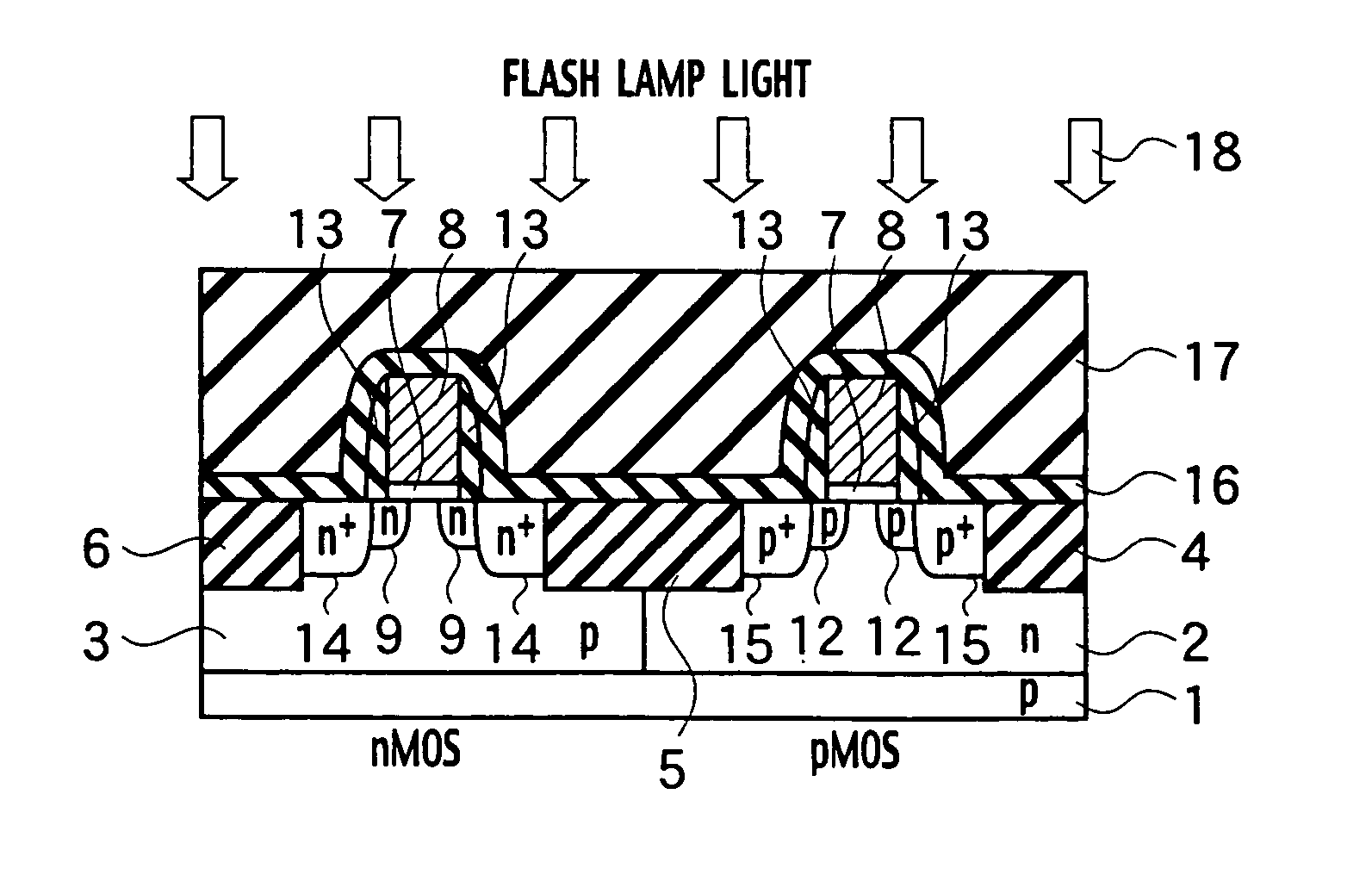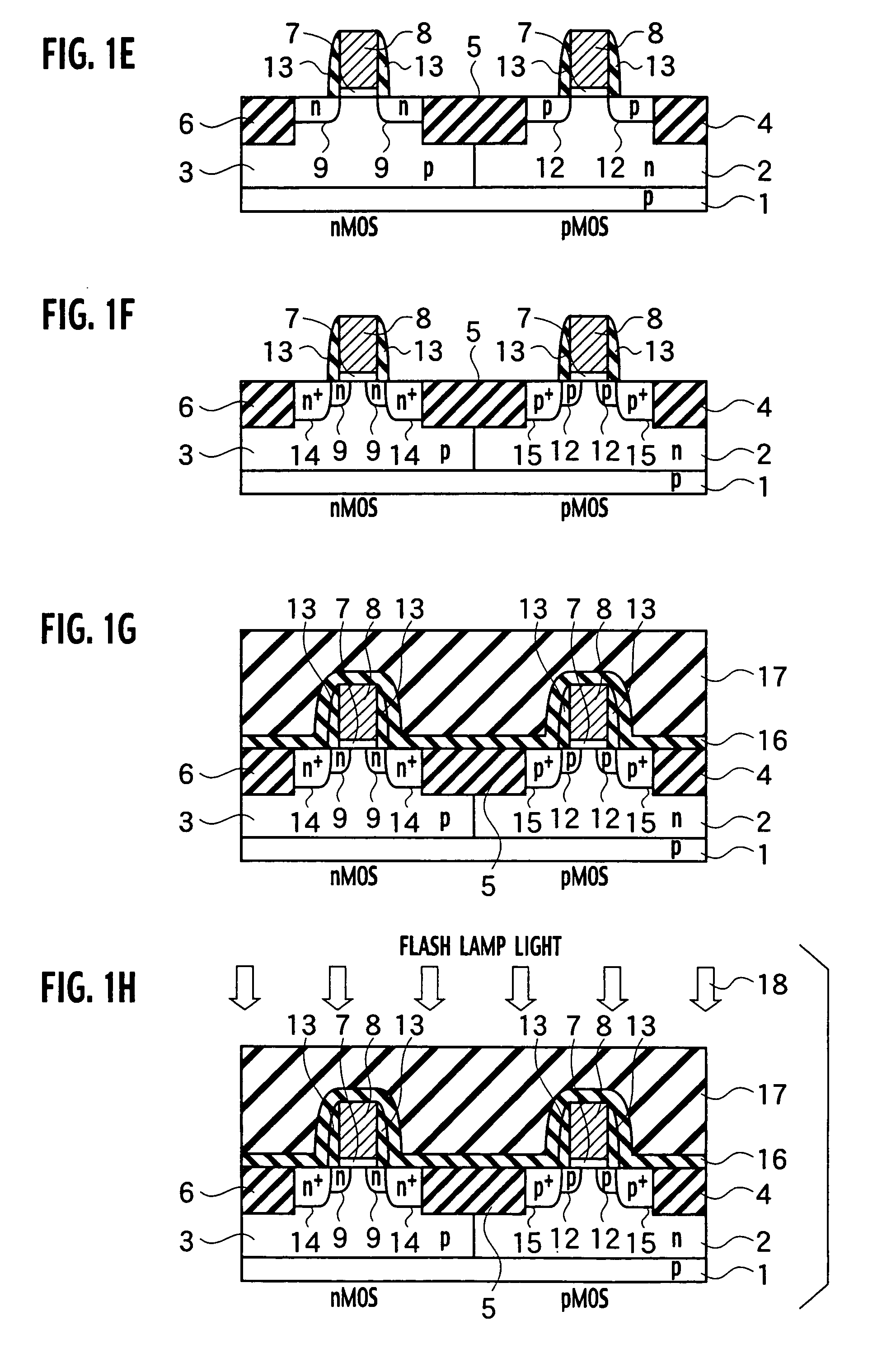Semiconductor device including a semiconductor substrate formed with a shallow impurity region, and a fabrication method for the same
a semiconductor substrate and impurity technology, applied in the direction of semiconductor devices, electrical devices, transistors, etc., can solve the problems of difficult to form a shallow impurity diffused region with a low resistance, difficult to effectively and instantaneously heat up the semiconductor substrate, and difficult to form a shallow pn junction concurrent with the miniaturization of the devi
- Summary
- Abstract
- Description
- Claims
- Application Information
AI Technical Summary
Benefits of technology
Problems solved by technology
Method used
Image
Examples
first embodiment
[0033] (First Embodiment)
[0034] A semiconductor device fabrication method according to a first embodiment is described, taking as an example, fabrication steps for CMOS transistors, which form an LSI semiconductor device.
[0035] To begin with, as shown in FIG. 1A, a p-well layer 3 is formed in the nMOS region of a p-type silicon (Si) substrate 1, and an n-well layer 2 is formed in the pMOS region. Isolation regions 4 and 6 are formed around the p-well layer 3 and the n-well layer 2, respectively. Furthermore, a silicon oxide film, to be a gate insulator film 7, is formed on the surface of the p-type silicon substrate 1.
[0036] Next, as shown in FIG. 1B, a polycrystalline silicon film, which becomes gate electrodes 8, is formed on the gate insulator film 7. The polycrystalline silicon film is selectively etched through reactive ion etching (RIE), so as to form the gate electrodes 8.
[0037] As shown in FIG. 1C, a photoresist film 10 is formed on the pMOS region. Using the photoresist ...
second embodiment
[0066] (Second Embodiment)
[0067] A semiconductor device according to a second embodiment is described taking CMOS transistors, which form an LSI semiconductor device, as an example.
[0068] The semiconductor device according to the second embodiment, as shown in FIG. 8, includes a silicon substrate 1, isolation regions 4 through 6 and 37 through 39, gate insulator films 7, gate electrodes 8, source / drain impurity regions 14 and 15, extension impurity regions 9 and 12, and auxiliary layers 35 and 36 that are silicon carbide layers or silicon nitride layers.
[0069] The silicon substrate 1 includes multiple device regions in the nMOS region and the pMOS region. The p-well 3 is deployed on the silicon substrate 1 in the nMOS region. The n-well 2 is deployed on the silicon substrate 1 in the pMOS region.
[0070] The isolation regions 4 through 6 and 37 through 39 are provided on the surface of the silicon substrate 1, isolating the device regions of the nMOS region and the PMOS region. The...
third embodiment
[0098] (Third Embodiment)
[0099] A semiconductor device according to a third embodiment is described taking CMOS transistors, which form an LSI semiconductor device, as an example.
[0100] As shown in FIG. 12, the semiconductor device according to the third embodiment has the silicon carbide layer or silicon nitride layer 35 deployed in a different position from that in the semiconductor device of the second embodiment in FIG. 8. The silicon carbide layer or silicon nitride layer 35 is provided on the underside of the silicon substrate 1.
[0101] A fabrication method for a semiconductor device according to the third embodiment is described taking as an example, fabrication steps of CMOS transistors, which form an LSI semiconductor device.
[0102] To begin with, as shown in FIG. 13A, the silicon carbide layer or silicon nitride layer 35 is formed on the underside of the silicon substrate 1 through plasma CVD. The thickness of the silicon carbide layer or silicon nitride layer 35 is set t...
PUM
 Login to View More
Login to View More Abstract
Description
Claims
Application Information
 Login to View More
Login to View More - R&D
- Intellectual Property
- Life Sciences
- Materials
- Tech Scout
- Unparalleled Data Quality
- Higher Quality Content
- 60% Fewer Hallucinations
Browse by: Latest US Patents, China's latest patents, Technical Efficacy Thesaurus, Application Domain, Technology Topic, Popular Technical Reports.
© 2025 PatSnap. All rights reserved.Legal|Privacy policy|Modern Slavery Act Transparency Statement|Sitemap|About US| Contact US: help@patsnap.com



